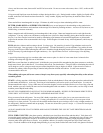4
11. DO NOT TOUCH control panel buttons after bread maker has been turned ON as this will interrupt the cycle. Turn bread
maker OFF after completion of cycle.
12. DO NOT LEAVE bread maker plugged into electrical outlet when not in use to prevent it from being accidentally turned
ON.
KNOW YOUR INGREDIENTS
Although bread making seems very basic, it is a science and the proportions of ingredients are critical. Read the following
information to better understand the importance each ingredient plays in the bread making process. Also, always make sure
your ingredients are fresh.
FLOUR is the main ingredient used in making bread and provides structure as well as food for the yeast. Several different
types of flour can be used in your bread maker, but DO NOT USE ALL-PURPOSE FLOUR, CAKE FLOUR or SELF-RISING
FLOUR, AS POOR RESULTS WILL BE OBTAINED.
Bread Flour SHOULD be used in your bread maker as it contains more gluten-forming proteins than all-purpose flour and will
provide tall, well formed loaves with good structure. Several different brands of bread flour are available for use in your bread
maker.
Whole Wheat Flour can be used in your bread maker at the special WHOLE WHEAT bread setting. Whole wheat flour
contains the entire wheat kernel, including the bran and germ, therefore breads made with 100% or a high percentage of whole
wheat flour will be lower in height and heavier in texture than bread made with bread flour. The WHOLE WHEAT bread
setting on your bread maker features longer kneading to better develop the structure of whole wheat bread for optimum results.
Rye Flour can be used in combination with bread flour in the preparation of rye or pumpernickel bread. It cannot be used alone
as it does not contain enough protein to develop adequate gluten for structure.
Special Notes on Flour: All flours are affected by growing conditions, milling, storage, humidity and even the manufacturer.
While not visibly different, you may need to make some minor adjustments when using different brands of flour as well as
compensating for the humidity in your area. Always store flour in an airtight container. Store whole grain flours (whole
wheat, rye) in refrigerator to prevent them from becoming rancid.
Measure the amount of flour as directed in the recipe, but make any adjustments after the first 8 – 10 minutes of
kneading as follows:
If dough does not form into a ball and is more like a batter in consistency, more flour will need to be added. Add 1 tablespoon
of flour at a time until dough forms into a soft ball and is not sticky to the touch. If too much flour has been added and the
mixture will not form into a ball, add 1 teaspoon of lukewarm water at a time, allowing the water to be kneaded into the dough
before adjusting further until a soft ball of dough forms. You can typically tell by the appearance of the dough when it is just
right as the dough will be soft in appearance but will not be sticky to the touch, and the sides and bottom of the bread pan will
be clean.
Do not exceed 3 cups of bread flour for the 1½ pound loaf or 2 cups bread flour for the 1 pound loaf. Breads containing whole
wheat, cereals or oats should not exceed a total of 3½ cups for the 1½ pound loaf; 2½ cups for the 1 pound loaf.
SUGAR AND OTHER SWEETENERS provide food for the yeast, add height and flavor to the bread and give the crust a
golden color. Types of sweeteners that can be used include sugar, brown sugar, honey, molasses, maple syrup, corn syrup and
fruits, whether dried or fresh. When using a liquid sweetener, such as honey or molasses, the total amount of liquid in the
recipe will need to be reduced slightly by the same measurement of liquid sweetener used. A special tip when measuring
sticky liquid sweeteners is to coat the measuring spoon with vegetable oil before measuring the sweetener; it will slide right
out. DO NOT USE ARTIFICIAL SWEETENERS AS A SUBSTITUTE FOR SUGAR AND OTHER NATURAL
SWEETENERS AS THE YEAST WILL NOT REACT PROPERLY AND POOR RESULTS WILL BE OBTAINED.
MILK enhances flavor and increases the nutritional value of bread. Any type of milk (whole, 2%, 1%, skim, buttermilk or
canned evaporated milk) can be used in making bread. Refrigerated milk MUST ALWAYS be warmed to between 80º to 90º F
before adding to the bread pan. Heat milk in glass measure in the microwave or in a small pan on top of the range until
lukewarm, but not hot. Use a thermometer to measure the temperature accurately. DO NOT OVERHEAT the milk, above
110ºF, as this can kill the yeast.
WATER used in combination with dry milk is a good substitute for regular milk and must be used when using the delay start
timer of your bread maker as regular milk will spoil when left at room temperature for several hours.


















